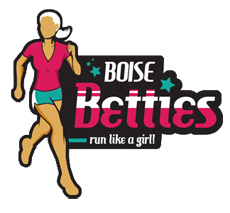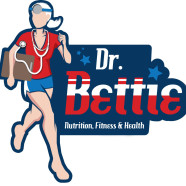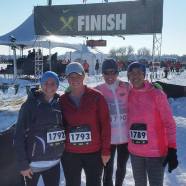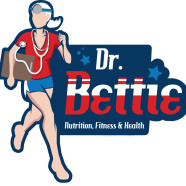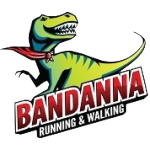DR. BETTIE: Run Naked and Tune In to Your Internal GPS
Welcome to Dr. Bettie’s Corner, your local expert in nutrition, fitness, and health! This is a bimonthly forum where we attempt to address Woman-focused topics of interest. We welcome your suggestions & questions! Please contact us with yours. Run Naked and Tune In to Your Internal GPS Earlier this fall I promised myself (and Coach G for accountability) that I would run the Turkey Day 5k “naked.” Don’t worry, no need to keep the kids inside (I left my streaking days behind in college) — I’m not talking about taking my clothes off, I’m talking about running sans GPS watch. Scary, right? How would I pace myself without technology? How would I do without knowing anything about my time? I’d heard some positive things about running without a GPS watch and was curious about trying it, but my type A personality is quite attached to glancing at my watch every so often while training and racing so I was not sure how I would do without it. As a frequent contributor to Runner’s World and similar running publications, coach Jenny Hadfield suggests that runners practice running without GPS devices so that we can tune into our own bodies and run at the pace our bodies are ready to run on any given day rather than becoming hyper focused on the number on the watch. While GPS watches are a valuable training tool, when overused they can prevent us from finding our internal GPS. Hadfield created three “effort-based” zones that we can try to visualize when running: Yellow Zone (Easy): You should be able to have a conversation and talk in full sentences. Orange Zone (Moderate): You should still be able to talk, but only in one or two word responses. Red Zone (Hard): You do not feel like talking when running in this zone. You need all of the oxygen you can get and do not want to use any of it for speaking. This is the anaerobic zone. Coach Hadfield recommends that when racing a 5k experienced runners warm up in the yellow zone and split the race evenly between the orange and red zone. So with that in mind, I put painters tape over my Bia GPS sports watch and prepared to give running naked a try. I pressed start on my watch, peeked under the tape to make sure it was running, put the tape down again and crossed over the start mat. I tried to find someone who seemed like he or she was running about my pace to pace myself off of, but that proved to be a difficult strategy. This might work in a longer race like a half or full marathon, but in a crowded turkey day 5k, it was just not possible. I was surrounded by all types of runners. Fast runners, slow runners, families running together, a runner in jeans, and runners in costume. I tried to just run in a straight line as best I could and find some sort of groove without doing too much weaving in and out of other people. The urge to peek underneath the tape was strongest during the first half mile or so. I kept looking down at my watch only to see blue painters tape with the message “Run Happy!” written on top. But how far had I gone? What was my average pace? My inquiring mind wanted to know! After glancing down at my wrist at least 27 times in the first 3 minutes of the race, my brain finally got the message that it was not going to get any...
Read MoreDR. BETTIE: Winter Running- Is the Weather Outside TOO Frightful?
Welcome to Dr. Bettie’s Corner, your local expert in nutrition, fitness, and health! This is a bimonthly forum where we attempt to address Woman-focused topics of interest. We welcome your suggestions & questions! Please contact us with yours. Winter Running: Is the Weather Outside TOO Frightful? It’s hard to believe it’s that time of year. (I mean, seriously hard to believe.) And nobody hates cold weather more than Dr. Bettie. (Pretty sure.) What can we do to survive these harsh days? Here’s a short list of advice, which I hope will help. The gear. There is no shortage of advice on this, with posts already available on Coach G’s main blog. A bullet summary: Windstopping shell, upper and lower. I find the more cash I shell out for the quality, the less crap I have to layer up. Lots of name brands to choose from, but probably anything geared toward running, with “windstopper” on it, is decent. (I personally love North Face, but I had to promise that nobody needed to buy me anything for a couple of Christmases as a result. Nuff said.) Outer vest is also an option. Base layer. If the weather is 15 degrees or warmer, I find the windstopper suit with a light sweat-wicking shirt inside is enough (like those underarmour, polypro type deals). If it’s colder, an extra layer of tights and slightly thicker upper layer is helpful. Something with Merino wool is particularly effective; there are multiple thicknesses available. Extremities. Hat and gloves, duh. May consider doubling the gloves when it’s less than 15 degrees. I’ve also noted that fluffy hats (with no windstopping ability) kind of suck when the digits are single outside; ear muffs could help here, or better yet, one of those ski hoodies that also includes neck/face/head coverage. And lastly, don’t be a ding-dong and get all suited up only to put on your regular cotton socks and shoes (like I did last week – brr!)…. Throw on the smart wool socks, or the like. Otherwise, I do NOT feel that “snow running shoes” are necessary, and the usual running shoes will suffice. Extra comforts. Gators are kind of nice if you are trudging out on ungroomed trails. If it’s actively snowing outside, don’t forget the viser/hat with brim – snow in the eyeballs can be annoying and somewhat painful. Safety. Those yaktraks are a swell idea. I just bought some. And of course, try to run close to home or have a backup plan (cell phone etc.) if something goes poorly. General rule. Stepping outside and feeling cozy? Step back on inside, take off a layer, and try again. (You overdressed.) Indoor warmup. This is a great way to get your core warm, which may take longer than usual in the chilly outdoors – and may help you feel a little better just getting started. Nothing crazy here, just a few pushups, situps, maybe a few jumping jacks should do the trick. Consider changing your stride – just a little – in the snow. This is for obvious safety reasons, with questionable footing and potential room for slippage out on the wintry trails or roads. Shortening your stride will keep you more compact and stable, with less potential to tweak a knee or wipe out. And finally… When is it too cold to run outside? Everybody has their own personal threshold. From a health/safety standpoint, I have seen colleagues claim that even 20 degrees below zero is “okay”. (If you’re completely nuts, that is.) My own threshold is “double digits”, but sure, I’ve gotten out there in...
Read MoreDR. BETTIE: Staying Motivated During the Fall and Winter Months
Welcome to Dr. Bettie’s Corner, your local expert in nutrition, fitness, and health! This is a bimonthly forum where we attempt to address Woman-focused topics of interest. We welcome your suggestions & questions! Please contact us with yours. Staying Motivated During the Fall and Winter Months Q: Dear Dr. Bettie, I just finished my big fall race, now what? How do I stay motivated to train during the fall and winter months? A: First of all, congratulations! It’s a huge accomplishment to complete an event that you have trained for all summer. Hope it was a great experience for you! Make sure you take some time off after the race to let your muscles fully recover. I recommend that you take a full week off of running after racing a full or half marathon. Just like tapering before a big event, recovery after the big event is also important. While you are resting, remember to stretch, drink lots of water and eat plenty of dark leafy greens to aid your recovery. When you do resume running, start with easy runs and gradually resume speed runs, hill runs, and longer runs. Fall and winter is a great time to work on strength training and shorter, speedier type races. Here are a few upcoming local races that you might be interested in: November 15: Cross Country Meet in Eagle November 27: Boise Turkey Day 5k December 20: YMCA Christmas Run And to really power and motivate you through those dark, cold months of winter, you may want to pick a longer spring race to focus on. Race to Robie Creek or the Famous Idaho Potato Marathon, perhaps? When logging all of those winter miles, remember to run safely in the dark. I recently learned a trick of wearing not only a headlamp on my head but a light clipped to my waist as well. The second light makes a huge difference with depth perception on the trails! And don’t forget your reflective gear. Remember to stay off muddy trails, and as the roads and trails become snowy or icy, you can run with Yaktrax attached to the bottom of your shoes for more traction over the snow and ice. Speaking of snow and ice, winter is a great time to incorporate some different cross-training activities such as nordic skiing into your routine. Finally, running with others makes running in the dark and cold both safer and more fun, so if you are still on the sidelines, please come join us soon for a run and enjoy running through the fall, winter and well into next...
Read MoreFall Racing Report
Wow! It’s about all I can say as I review the many weekends full of superb races, fantastic PRs and lots of happy runners. I am blown away by the performances handed in over the last month; I don’t even know where to begin. Perhaps I should work backwards…. This weekend marks the second year Rachel Goochey and her sister Abby raced in Arizona’s Be The Match 5k. The run raises money for bone cancer research and the girls run in memory of their lovely mother, Mary Kay. Such an inspirational woman; such a great family- big hugs and high fives to Rachel and Abby! Last weekend, the newest memberof the team, Erica Richardson ran 5k XC in the Lewis-Clark home meet to an outstanding time of 17:27! Awesome prospects for this postpartum mama- Congrats Erica! City of Trees boasted incredible weather and a fun group of gals out to run the full and half marathons. Candace Madarieta Smith completed the full in a stellar time of 4:15:51- good for 7th in her age group. Candace was on a roll this fall as she also ran a huge PR in the Barber to Boise 10K, running 48:54 and a 1:55:47 in the Fit One Half Marathon. Awesome racing Candace! Samantha Andreas ran her half marathon debut at the City of Trees in 1:51:59- a huge show of heart and muscle as she hit the gas instead of the breaks at mile 10! Sam says sage was helped along by keeping an eye on the pink singlet just ahead of her- teammate Jackie Pronovost who ran a season best 1:49:14, despite the training interruption recently. Shalini Ramachandran and Claire Boyd ran close together in the City of Trees half, finishing in 2:25:16 and 2:26:14 respectively. Love the teamwork, ladies! Claire donned the Betties’ singlet for the first time at COT but I have to give mention to the fact that this was her 4th Half this year, peaking with the perfect conditions of FitOne with a time of 2:20. Way to put the miles in Claire! Speaking of marathons, Gabby Reeves ran her debut at the Portland Marathon earlier this month. Coming through the finish at 3:11, her race stands out given the heat and the fact that she only started racing seriously in the last year. Incredible effort in your first marathon, Gabby! Looking forward to great things in the months and years to come! FitOne was the big race for many, and the Betties were out in full force. Nicole Fitzgerald led the 5K from the start, Layla Brown and Maria Morgan showed us their strength by racing the competitive stroller division (with Maria pushing a TRIPLE stroller and 3 toddler boys), Sam paced an easy 10k as a workout (still finishing 6th for women!), but the highlight may have been Samia McCall‘s incredible half marathon. Though the course was long- 13.4 according to the race website- Samia ran a 1:51:51 for a huge PR, resetting a personal record that had stood for years! Samia went on to run a 10K PR at Barber to Boise (though she was intending to just run, not race) in 50:27. Just seconds behind her was another new member to the team, Amber Kiertly-Perez in 50:36! Again, awesome AWESOME running. So proud of these gals! Our last big race before the new year is the Zeitgeist Half Marathon– a classic hilly Boise course that keeps the runners coming back every year. I know we have two signed up, so look for the pink singlets out on the course and get ready to celebrate a few more incredible performances! Happy Trails! coach G Candace Madarieta-Smith Shalini Ramachandran Jackie Pronovost...
Read MoreDR. BETTIE: Drink Up, Buttercup: Staying Hydrated for Half and Full Marathons
Welcome to Dr. Bettie’s Corner, your local expert in nutrition, fitness, and health! This is a bimonthly forum where we attempt to address Woman-focused topics of interest. We welcome your suggestions & questions! Please contact us with yours. Drink Up, Buttercup: Staying Hydrated for Half and Full Marathons We all know (or should know) that staying hydrated is important but what is the best way to go about staying hydrated during long runs and races (half marathon distance or longer)? Below are some tips: Hydration should not begin the morning of a long run or race, but sooner. At least 48 hours before the endurance event we should be making efforts to stay well hydrated. Try to sip fluids throughout the day during the days leading up to your long run or race. The American College of Sports Medicine has recommended drinking 5 to 12 ounces of fluids every 15 to 20 minutes during a marathon. However, this is often difficult to accomplish and may result in over-hydration depending on how much you are sweating (not to mention too many detours to the port-a-potty). The best thing to do is experiment with your own personal hydration needs during your long runs so that you will be ready for race day. Every runner is different and hydration needs will also vary depending on the weather, heat and how much you are sweating. After a long run you may want to check your weight to make sure you have not lost more that 2 percent of your body weight. Also be sure that your urine is not too dark. These are signs that you have become too dehydrated and that you need to hydrate more before and/or during your run. To hydrate just before a half or full marathon, try drinking two 8 ounce glasses of water or sports drink two hours before the start of the race to give your body enough time to absorb and digest all of the fluids. Wear a hydration belt to ensure that you will always have fluids available. Fuel belt and Fitletic both make good ones for running. You will also need to replace electrolytes (sodium, potassium and magnesium) lost while sweating during long runs and races. If you are not eating gels periodically or taking an electrolyte tab to replace lost electrolytes, then you may wish to consider drinking a sports drink instead of water. But be careful not to take in too many electrolytes and/or gels. If you are only drinking a sports drink, dilute it half and half with water. There are several recipes for homemade and natural versions of sports drinks available online such as this one: mix ¼ cup of freshly squeezed lime juice, ¼ cup freshly squeezed lemon juice, 1 ½ to 2 cups fresh water (depending on how strong you want the flavor and/or how diluted you need the drink to be), ⅛ teaspoon of sea salt, and 2 tablespoons natural sugar or honey, to taste, and viola!, you have your very own sports drink! The gels are great for fueling during half marathon and marathon racing (and thus you need to practice using them occasionally during your half marathon and marathon training) and also on training runs over two hours, but be careful not to use them too frequently. You generally want your body to use fat and glycogen stores for fuel rather than carbs from the gels. Don’t forget to rehydrate after a long run or race to replace the fluids that you have lost. Your body needs them. Being dehydrated causes your blood...
Read More